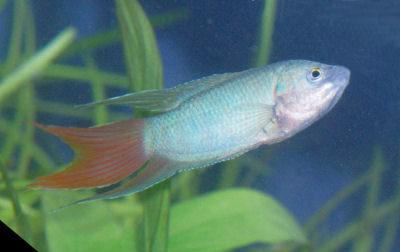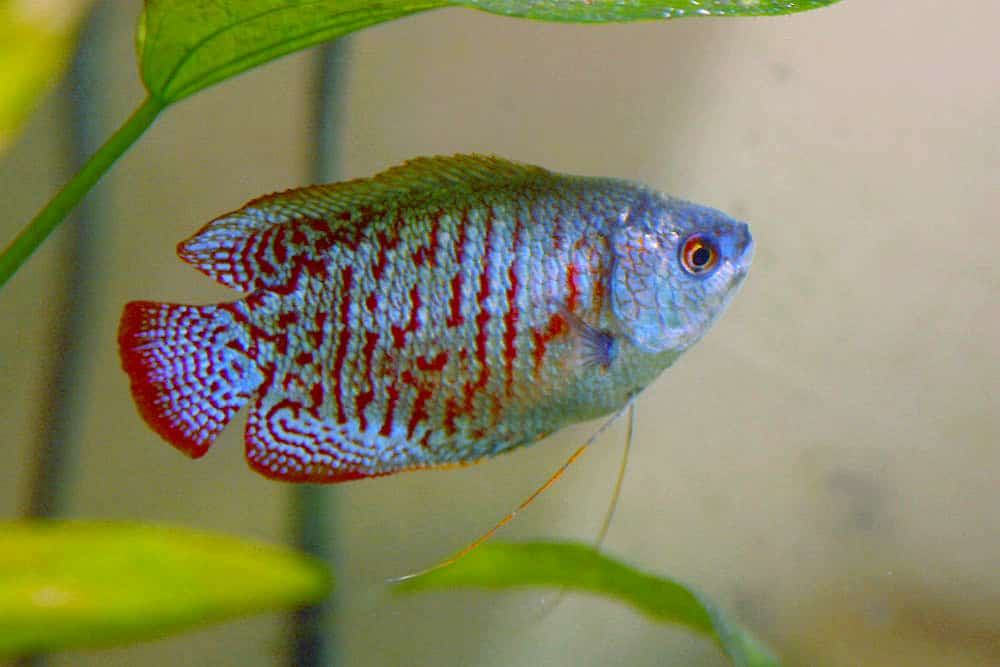
The best known Labyrinth fish include the Betta (Siamese Fighting fish), Gouramis, and Paradise Fish!
The Labyrinth fish, also called Anabantoids, are distinguished from all other types of fish. Most fish receive oxygen by passing water through their gills. However these fish possess an additional respiratory organ called the “labyrinth organ”, which gives them the distinct ability to breath oxygen.
These fish can breath atmospheric oxygen in the event the water they live in becomes depleted of oxygen or polluted. They can survive in shallow waters and even dried ponds as long as they stay moist. As long as they stay humid they can survive for hours outside of water. They can even search for new water since they can “walk” on their pectoral fins. One species Anabas testudineus is said to even be able to climb trees, and so is known as the Climbing Perch.
Labyrinth fish also have a fascinating brood care. They range from bubble-nests builders at the surface of the water to nest building in underwater plants, and some practice mouthbrooding. In an aquarium you can see a cluster of bubbles on the top of the water. Once the female lays the eggs, the male will pick them up in his mouth and put them in his bubble nest. The male will continue to guard the eggs until they hatch.
Anabantoids are generally hardy fish and many are great for the beginner. Some of the best known examples of labyrinth fish are the Gouramis, the Bettas including the popular Siamese Fighting fish, and the Paradise fish. They usually prefer slightly acidic water but with a low current that won’t disturb their bubble nests. Most like a well lit planted tank, but with some floating plants and a few hiding places created with rocks or driftwood. They will usually readily accept aquarium foods like flakes and tablets, as well as enjoying supplements of brine shrimp and various types of worms.
The Labyrinth species list below includes popular types as well lesser known varieties. Each fish guide has a description of the species, its place of origin, habitats and behaviors, as well as fish care to successful maintain them in an aquarium. Fish pictures are also provided within each fish guide to help with identification, and to aid in choosing the best type of Labyrinth fish for your freshwater tank.
- Bettas, Paradise Fish, Others
- Gourami Fish – Dwarf Gourami, Kissing Gourami, Blue Gourami, and more
For Information on keeping freshwater fish, see:
Freshwater Aquarium Guide: Aquarium Setup and Care
Labyrinth Fish Facts
The majority of the Labyrinth fish are found in Asia throughout the south, southeast, and eastern portions of the continent inhabiting warm, slow-flowing, low-oxygen waters. They also occur in tropical rainforest waters on the lower half of the African continent.
These are relative newcomers in the world of fishes in terms of evolution. They all have the common characteristic of having a supplementary respiratory organ called the “labyrinth organ”. This organ gives them the distinct ability to breath oxygen.
This type of adaptation probably first developed about 50 to 60 million years ago. One gourami fossil has been found in the lake-bed shales of Central Sumatra. It was tentatively ascribed to the Giant Gourami Osphronemus, but it is unknown if fossils occur in Africa.
Fish have gills and they receive oxygen by passing water through their gills. Labyrinth fish also use their gills, but can also obtain an additional oxygen supply from the atmostphere. The labryinth organ is located in the head just behind the gills. It looks like a maze which traps air in its’ many folds. These fish will to go to the surface to gulp air. The oxygen from this air finds its way through the maze and is then absorbed directly into the bloodstream.
The gills in these fish can be greatly degenerated and the labyrinth organ can vary in size. The organ size is dependent on the oxygen content in the waters where each fish lives and is acclimated to. So from one fish to the next, the size of the organ will be different.
Labyrinth Fish Species
Labyrinth fish belong to the large order of Perciformes known as perch-like fishes. This is the largest order of the vertebrates. It contains at least 18 suborders with around 160 families of fish of all sorts and sizes.
They are also known as Anabantoids as they belong to the Anabantoidei suborder of Perciformes. There are three families of Anabantoids. These include the Osphronemidae family which contains the largest group of Gouramis. Then there are the Climbing Gouramis in the Anabantidae family and the Kissing Gouramis of the Helostomatidae family. Currently there are 20 genera containing about 128 described species and at least 7 that are not yet described.
- Osphronemidae Family- Gouramis
The Osphronemidae is the largest Anabantoid family. It is broken into 4 subfamilies which contain 96 species in about 15 genera. These fish are found in Asia, from Pakistan and India to the Malay Archipelago and north-easterly towards Korea. Theis family contains some of the most familiar and popular aquarium species, as well as many others.
The Osphronemidae family contains the Betta genus with 96 species, including the popular Siamese Fighting Fish Betta splendens. It also contains the familiar Gouramis of the Trichogaster, Trichopodus, and Trichopodus genus (previously the Colisa genus), the Giant Gouramis of the Osphronemus genus, various Paradisefish, Combtail Gouramis, and a few others.
- Anabantidae Family – Climbing Gouramis
Anabantidae is the second largest Anabantoid family with 4 genera containing 31 described species and at least 7 species not yet described. These fish are found from Africa to India and in the Philippines. They are egg-layers that will typically guard their eggs and young.
This family includes the intriguing Climbing Perch of the Anabas genus. They are also called Climbing Gourami, named because of some reports indicating that they can climb trees. These fish are also often referred to as “walking fish” because although they don’t actually walk, they can move by extending the edges of their gill plates for support and then pushing themselves forward with their fins and tail. They are actually used as an Asian food fish and only rarely kept in the aquarium. Another group included here are the African labyrinth fishes, such as Ctenopoma genus.
- Helostomatidae Family – Kissing Gouramis
Helostomatidae is the third family with only 1 genus and containing only 1 described species. That species is the Kissing Gourami Helostoma temminki, also known as the Kissing Fish or Kisser.
The Kissing Gourami is found from Thailand to Indonesia and it is farmed as a food fish. Though it is a highly specialized filter feeder, it is also a popular aquarium fish. It has two color morphs, green and an orangish pink. Green color morphs originate from Thailand and the orangish pink varieties are from Java. There is also a captive bred mutation with a small, rounded body. It is known as the Dwarf Kissing Gourami or Balloon Pink Kissing Gourami.
Labyrinth Fish Care
In general the labyrinth fish are very adaptable in the aquarium and are moderately easy to care for. In the wild these fish live in a variety of waters from rivers and streams, to ponds, irrigation ditches, and flooded fields. These waters are usually vegetated and some are even polluted.
When kept in the aquarium they are not too concerned about water quality. Most will mostly thrive and even breed in slightly acidic medium hard to soft water. They tolerate a wide range of temperatures from 68 – 80 F ( (20 – 27 C). There are just a few exceptions. The Chocolate Gourami Sphaerichthys osphromenoides for example, needs very acid water. There are also a few others with special needs like the species from the Parosphromenus genus.
Most will enjoy a well lit tank but one that is not overly bright. They like lots of plants including some floating plants, and most like having places to retreat in driftwood or rocks. They don’t need a lot of aeration and lower water movement is especially appreciated by the bubble nest builders. They usually readily accept aquarium foods like flakes and tablets, as well as enjoying supplements of brine shrimp and various types of worms.
Overall these are undemanding fish with a calm nature. They can make a great addition to most community aquariums. Good tankmates include Tetras, peaceful Barbs, and bottom dwellering Catfish and Gobies. They get along with other Labyrinth fish too, as long as they are similar in size. Aggressive fish like cichlids should be avoided.
Featured Image Credit: Openverse


WFA_Ap4Be_vsm.jpg)

GouramiWFA_C2265_vsm.jpg)

WFA_Ap8AF_vsm.jpg)






WFA_Ap4AGo_vsm.jpg)



WFA_Ap8AF_vsm.jpg)

_ColisaLabiosusWFA_C2407_vsm.jpg)